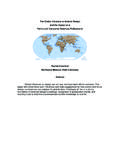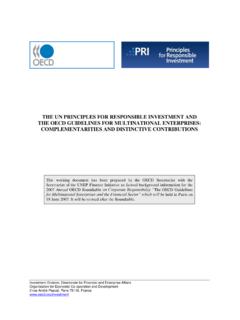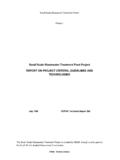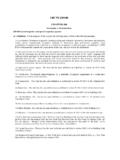Transcription of Leadership Responsibilities of Professionals
1 Leadership Responsibilities of Professionals Dorothy I. Mitstifer This chapter introduces a Leadership development model that raises the question: Leadership for what? Leadership is about going somewhere personally and in concert with others in an organization1. Although Leadership is often discussed in terms of leader qualities and skills, especially position Leadership , the matter of Leadership as a responsibility of each professional receives little attention. Organizations and programs do not flourish with one leader in a group. Thus, more attention has to be paid to the definition of leader as anyone willing to help (Wheatley, 2005). Leadership is not about position only, but about taking responsibility as a member of a group (whether 2-person or 60-person) to share Leadership for the organization s well-being. Despite the investments in time, money, and energy, Leadership development programs in many organizations are often piecemeal, focused on aspects in isolation (Ready, 2004).
2 They may offer the latest competency program, an up-to-date performance management system, a sophisticated assessment instrument, the latest electronic learning package, and/or a program built around available speakers and facilitators known to the Leadership development committee. In these approaches, there is also a danger in focusing on local issues to the exclusion of broad, sweeping issues of importance to the national or international perspective for the organization. Then, too, we live in a world that is different and changing so fast that former approaches just don t serve the current and future needs of organizations. Each organization needs to learn how to grow its own leaders, but it needs a theoretical framework to accomplish this worthy objective. The South American poet Machados declared, The road is your footsteps, nothing else (Wheatley, 2005, p.)
3 43). The Leadership development model described in this chapter is intended to guide your footsteps in a direction that clarifies your personal and professional journey and shares responsibility among colleagues for the well-being of your organization. The following sections will discuss the basic components of a Leadership development model, a Leadership theory, issue framing, and a concluding section that ties everything together as a comprehensive approach to Leadership development. Basic Components of the Reflective Human Action Leadership Development Model If the premise is accepted that an organization cannot succeed without position Leadership and group members sharing Leadership Responsibilities , it is then incumbent upon each organization to establish an intentional program to develop Leadership skills at all levels. Presently, pre- Professionals and Professionals , alike, experience Leadership development in a haphazard manner.
4 In some ways, Leadership of a profession is more important than content to carry on its mission and practice. The proposed Reflective Human Action (RHA) Leadership Development Model (Figure 1) focuses on (a) strengthening self-awareness, (b) developing relationships and teamwork, (c) understanding alliances and political realities, (d) understanding the elements of a promising future of the organization, and coupled with (e) Reflective Human Action (RHA) Leadership theory as its foundation and framing as a communications tool. It is hypothesized that the model will enable individuals to assume Leadership Responsibilities as Professionals . At its base this model states the philosophy that underlies Leadership ; the next level includes the basic components of Leadership development that are coupled with theory and with competency in framing all leading to the overall objective: organizational Leadership .
5 The following section explains the four basic components of the Model. Figure 1. Reflective Human Action (RHA) Leadership Development Model 2005 by Dorothy I. Mitstifer. Used by permission. All rights reserved. I. Strengthening self-awareness People live in their own world of self-generating beliefs, which are often untested (Ross, 1994). These beliefs are the product of past experience and inferences from observations. Argyris (1990) labeled this phenomenon the ladder of inference, a mental pathway based upon observable data and experiences and composed of the data selected, the meanings assigned, the assumptions made, conclusions drawn, beliefs adopted, and actions taken. If all of these components are unquestioned and untested, these inferences may lead to misguided beliefs. But one s self-awareness can be strengthened by reflection (becoming more aware of one s own thinking and reasoning), advocacy (making one s thinking and reasoning more visible to others), and inquiry (inquiring into other s thinking and reasoning) (adapted from Ross, 1994, p.)
6 245). Ross suggested the following questions that can assist a group in testing beliefs: What are the observable data behind that statement? Does everyone agree on what the data are? Can you run me through your reasoning? What is the basis of your interpretation? When you said _____, did you mean _____? The ladder of inference is a tool for examination of one s own beliefs and actions and contributes to a healthy climate for reflection in organizational matters. II. Developing relationships and teamwork Collaborative Leadership within an organization by definition requires that one s self-knowledge be applied in interaction with others to develop relationships and teamwork. Collaboration is a worthy skill because it provides many benefits: a unified approach, effective internal decision making, reduced costs through shared resources, and more creative outcomes (Weiss & Hughes, 2005).
7 But collaboration is not easily achieved. To improve collaboration, the issue of conflict must be addressed. Differences in perspective, competencies, access to information, and strategic focus cause conflict, so acknowledgement and development of processes to manage it are necessary precursors to effective collaboration. By exploring all of the differences, conflict situations produce benefits by providing new insights and possibilities for improving organizational decisions and outcomes. Effective collaboration requires both individual and network expertise. Connectivity gained through networks produces synergistic outcomes, but it has its downside as well: countless meetings can drain time and energy. So, there is a need to develop a strategic, sophisticated view of collaboration .. (Cross, Liedtka, & Weiss, 2005). The appropriate degree of connectivity must be determined for achieving specific results required of the organization.
8 Some tasks will require all players while others can be assigned to specific networks, all the while maintaining openness and communication to ensure understanding and transparency. Collaborative leaders know that you can t force collaboration, but you can expect it. It requires discipline and dogged persistence in expecting collaborative behavior. When leaders consistently ask questions that remind people of those expectations, they tend to get what they expect (Linden, 2003, p. 47). A collaborative leader should be able to Articulate the project s purpose in a way that excites others. Be an effective convener: get the appropriate people to the table and keep them there. Help the participants see their common interests and the benefits possible through joint effort. Generate trust. Help the participants design a transparent, credible process.
9 Assist the participants in win-win negotiations to meet three related interests (needs of each partner, of the product they are creating, and of the relationships involved). Make relationship building a priority for the group. See that there s a senior champion of the effort. Help everyone engage in collaborative problem solving and make creative use of their diverse viewpoints when differences arise. Celebrate small successes; share credit widely. Provide confidence, hope, and resilience. (Linden, 2003, pp. 42-44) Accompanying the above tasks is the disposition to have persistence, energy, and resolve; passion about achieving a collaborative outcome; the ability to pull others rather than push them in a collaborative direction; and the ability to think systemically and see the interconnections (Linden, 2003, p. 45). III.
10 Understanding alliances and political realities Relations, between and among people, are often uncertain, fluid, and complex. These relationships often include alliances formed on the basis of values and interests of a core of like-minded individuals. Thus, an organization needs to examine the alliances in the group to find the mutual points of agreement upon which to build trust. Although these alliances may be political realities, it isn t useful to label their activities as political. So-called political intelligence, however, is needed to identify how relationships are likely to affect success (Ciampa, 2005). Political skills include the use of power and influence to enhance or protect interests, thus group members need to be encouraged to go out of their way to help the group find ways to be sensitive to the various points of view and to be respectful of diverse spheres of interests.








